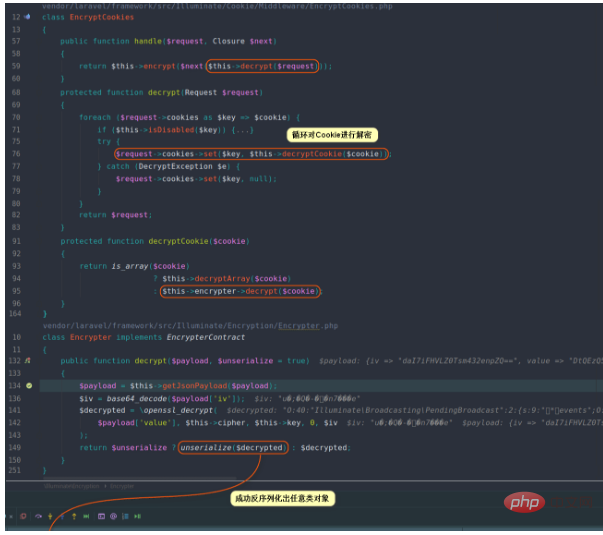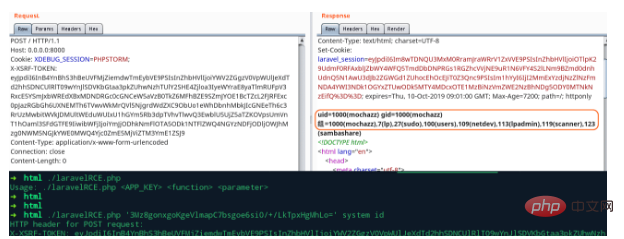The following tutorial column is developed by Laravel to introduce you to Laravel's method of repairing website vulnerabilities. I hope it will be helpful to friends in need!

The Laravel framework is a development framework currently used by many websites and APP operators. Because there are so many websites used, many attackers are constantly attacking We conducted vulnerability testing on the website. When we conducted vulnerability testing on the system, we found that there was a REC vulnerability. It was mainly an XSRF vulnerability. Let's analyze the vulnerability in detail, how to exploit it, and how to fix it. Record.
The exploitation of this Laravel REC vulnerability requires conditions. The APP_KEY must be leaked before it can be successfully exploited and triggered. Our SINE security technology discovered a total of There are two places where website vulnerabilities can occur. The first is the cookies field in the Post packet, and the other is the HTTP header field where malicious total code can be inserted into the website backend.
Let’s build it Let’s take a look at the environment for website vulnerability testing. We use linux centos system, PHP5.5 version, the database is mysql, and it is built using apache environment. The Laravel version used is 5.6.28. First, we go to the official website to download the version and unzip it to the apache setting. Website directory path. First of all, in our post data, we can see that in our code, we will call more than a dozen classes, call objects in the classes, and assign parameters. In the cookies and verifycsrftoken values, we found that app_key can be used for vulnerability exploitation. First we use cookies to reproduce it:

The code is as follows:
POST / HTTP/1.2 Host: 127.0.0.2:80 Cookie: safe_SESSION=PHPSTORM; 5LqG5L+d6K+B5omA6L6T5Ye655qE57yW56CB5L2N5Y+v6K+75a2X56ym77yMQmFzZTY05Yi25a6a5LqG5LiA5Liq57yW56CB6KGo77yM5Lul5L6/6L+b6KGM57uf5LiA6L2s5o2i44CC57yW56CB6KGo55qE5aSn5bCP5Li6Ml42PTY077yM6L+Z5Lmf5pivQmFzZTY05ZCN56ew55qE55Sx5p2l44CCDQoNCkJhc2U2NOe8lueggeihqA==; Content-Type: application/x-www-form- Connection: open Content-Length: 1
The above code is in the cookies column. The encrypted value is what we want The forged attack code submits the POST request to the website. It will first decrypt the APP_key and assign it a value. If the decryption is successful, the value in the cookies will be verified and deserialized, and then If the vulnerability occurs, the RCE vulnerability will be triggered.
Let’s test the vulnerability using the http header method. First, we will construct a code similar to cookies, as follows:
POST / HTTP/1.2 Host: 127.0.0.2:80 X-XSRF-TOKEN: +B5omA6L6T5Ye655qE57yW56CB5L2N5Y+v6K+75a2X56ym77yMQmFzZTY05Yi25a6a5LqG5LiA5Liq57yW56CB6KGo77yM5Lul5L6/6L+b6KGM57uf5LiA6L2s5o2i44CC57yW56CB6KGo55qE5aSn5bCP5Li6Ml42PTY077yM6L+Z5Lmf5pivQmFzZTY05ZCN56ew55qE55Sx5p2l44CCDQoNCkJhc2U2NOe8lueggeihqA==; Content-Type: application/x-www-form- Connection: open Content-Length: 1

Look here at the X-XSRF-TOKEN: value. The Laravel framework will judge and verify this value during the submission process. If the decryption is successful, the deserialization operation will be performed. I won’t go through it one by one here. Introduction and explanation.
How to fix Laravel's vulnerability?
Our SINE security technology upgraded the Laravel version and found that the latest 5.6.30 version has the rce vulnerability Repairs have been made. From our code comparison, we can see that the decryption and parsing operations of cookies have been judged, and the static::serialized() value has been written more. This is also added to X-XSRF-TOKEN. Value. If you don’t know much about the code, you can also find a professional website security company to repair it. This is the website vulnerability detection and testing for Laravel. I also hope that through this sharing, more people can understand it. Website vulnerabilities, the causes of vulnerabilities, and how to fix them. Only when the website is safe can we open up our hands and feet to develop the market and do a good job in marketing.
The above is the detailed content of How Laravel fixes website vulnerabilities. For more information, please follow other related articles on the PHP Chinese website!

Hot AI Tools

Undress AI Tool
Undress images for free

Undresser.AI Undress
AI-powered app for creating realistic nude photos

AI Clothes Remover
Online AI tool for removing clothes from photos.

Clothoff.io
AI clothes remover

Video Face Swap
Swap faces in any video effortlessly with our completely free AI face swap tool!

Hot Article

Hot Tools

Notepad++7.3.1
Easy-to-use and free code editor

SublimeText3 Chinese version
Chinese version, very easy to use

Zend Studio 13.0.1
Powerful PHP integrated development environment

Dreamweaver CS6
Visual web development tools

SublimeText3 Mac version
God-level code editing software (SublimeText3)

Hot Topics
 Laravel Vue.js single page application (SPA) tutorial
May 15, 2025 pm 09:54 PM
Laravel Vue.js single page application (SPA) tutorial
May 15, 2025 pm 09:54 PM
Single-page applications (SPAs) can be built using Laravel and Vue.js. 1) Define API routing and controller in Laravel to process data logic. 2) Create a componentized front-end in Vue.js to realize user interface and data interaction. 3) Configure CORS and use axios for data interaction. 4) Use VueRouter to implement routing management and improve user experience.
 How to test Laravel API interface?
May 22, 2025 pm 09:45 PM
How to test Laravel API interface?
May 22, 2025 pm 09:45 PM
Efficient methods for testing Laravel API interfaces include: 1) using Laravel's own testing framework and third-party tools such as Postman or Insomnia; 2) writing unit tests, functional tests and integration tests; 3) emulating a real request environment and managing database status. Through these steps, the stability and functional integrity of the API can be ensured.
 How to customize Laravel's user authentication logic?
May 22, 2025 pm 09:36 PM
How to customize Laravel's user authentication logic?
May 22, 2025 pm 09:36 PM
Custom Laravel user authentication logic can be implemented through the following steps: 1. Add additional verification conditions when logging in, such as mailbox verification. 2. Create a custom Guard class and expand the authentication process. Custom authentication logic requires a deep understanding of Laravel's authentication system and pay attention to security, performance and maintenance.
 How to create Laravel package (Package) development?
May 29, 2025 pm 09:12 PM
How to create Laravel package (Package) development?
May 29, 2025 pm 09:12 PM
The steps to create a package in Laravel include: 1) Understanding the advantages of packages, such as modularity and reuse; 2) following Laravel naming and structural specifications; 3) creating a service provider using artisan command; 4) publishing configuration files correctly; 5) managing version control and publishing to Packagist; 6) performing rigorous testing; 7) writing detailed documentation; 8) ensuring compatibility with different Laravel versions.
 Laravel integration with social media login (OAuth)
May 22, 2025 pm 09:27 PM
Laravel integration with social media login (OAuth)
May 22, 2025 pm 09:27 PM
Integrating social media login in the Laravel framework can be achieved by using the LaravelSocialite package. 1. Install the Socialite package: use composerrequirelaravel/socialite. 2. Configure the service provider and alias: add relevant configuration in config/app.php. 3. Set API credentials: Configure social media API credentials in .env and config/services.php. 4. Write controller method: Add redirection and callback methods to handle social media login process. 5. Handle FAQs: Ensure user uniqueness, data synchronization, security and error handling. 6. Optimization practice:
 How to implement password reset function in Laravel?
May 22, 2025 pm 09:42 PM
How to implement password reset function in Laravel?
May 22, 2025 pm 09:42 PM
Implementing password reset function in Laravel requires the following steps: 1. Configure the email service and set relevant parameters in the .env file; 2. Define password reset routes in routes/web.php; 3. Customize email templates; 4. Pay attention to email sending problems and the validity period of tokens, and adjust the configuration if necessary; 5. Consider security to prevent brute-force attacks; 6. After the password reset is successful, force the user to log out of other devices.
 Common security threats and protection measures for Laravel applications
May 22, 2025 pm 09:33 PM
Common security threats and protection measures for Laravel applications
May 22, 2025 pm 09:33 PM
Common security threats in Laravel applications include SQL injection, cross-site scripting attacks (XSS), cross-site request forgery (CSRF), and file upload vulnerabilities. Protection measures include: 1. Use EloquentORM and QueryBuilder for parameterized queries to avoid SQL injection. 2. Verify and filter user input to ensure the security of output and prevent XSS attacks. 3. Set CSRF tokens in forms and AJAX requests to protect the application from CSRF attacks. 4. Strictly verify and process file uploads to ensure file security. 5. Regular code audits and security tests are carried out to discover and fix potential security vulnerabilities.
 What is Middleware in Laravel? How to use it?
May 29, 2025 pm 09:27 PM
What is Middleware in Laravel? How to use it?
May 29, 2025 pm 09:27 PM
Middleware is a filtering mechanism in Laravel that is used to intercept and process HTTP requests. Use steps: 1. Create middleware: Use the command "phpartisanmake:middlewareCheckRole". 2. Define processing logic: Write specific logic in the generated file. 3. Register middleware: Add middleware in Kernel.php. 4. Use middleware: Apply middleware in routing definition.






